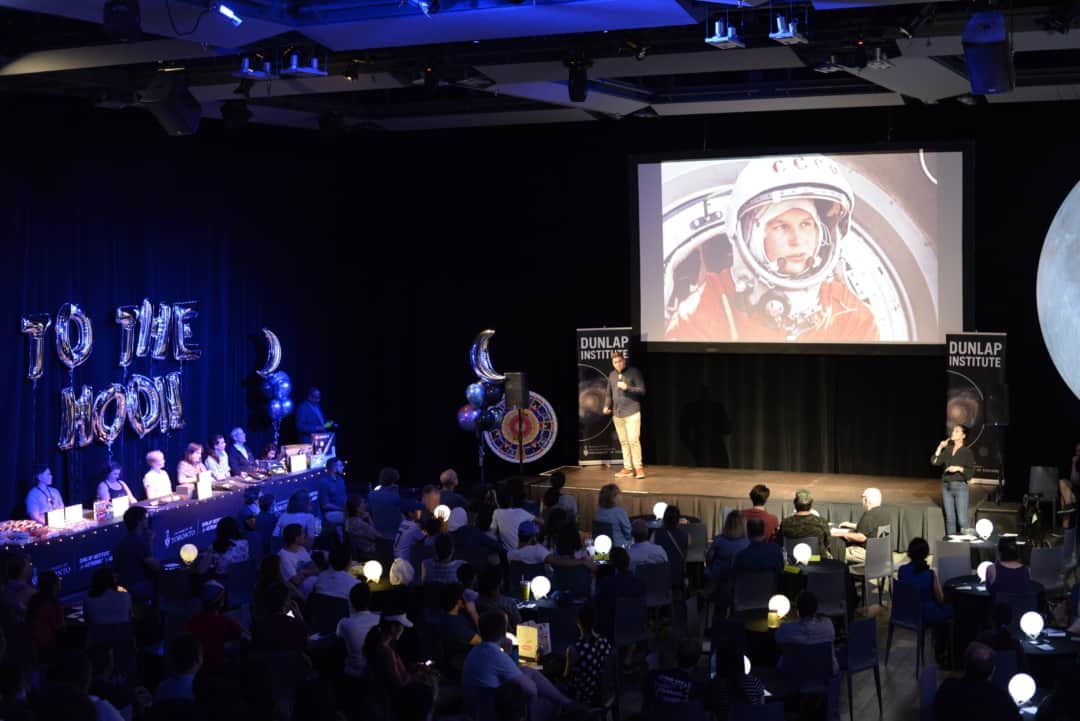On Saturday, July 20, U of T’s Dunlap Institute for Astronomy & Astrophysics celebrated the 50th anniversary of the Apollo 11 Moon landing with a SpaceTime event at the Daniels Spectrum.
The public event took place precisely 50 years to the day that astronauts Neil Armstrong and Buzz Aldrin became the first humans to take “one small step” onto the lunar surface at the climax of the Apollo 11 mission. Accordingly, the event focused on milestones in crewed space exploration, particularly surrounding the moons of our solar system.
The key attractions were three talks presented by experts in the space industry and academia. Interspersed between the talks were shorter anecdotes on spaceflight, chosen to augment the main features. Audience members were also able to participate through show-style games involving trivia and artwork.
The evening’s first speaker was William Maxwell King, a Master of Applied Science candidate at the U of T Institute for Aerospace Studies.
King’s presentation was titled “Spaceflight: A Human History,” and took the audience on a journey from the first rockets to the first Moon landing. Beginning with the origins of modern rocketry in the aftermath of World War II, the accompanying slideshow featured photographs of early rockets such as the United States’ Bumper 2, which was based on the German V-2 rocket. Similar pictures showed early Soviet successes in space before the triumph of the National Aeronautics and Space Administration (NASA)’s Apollo program.
King selected a historical angle for his talk to showcase the incredible progress that human ingenuity made over a very short span of time.
“I think the lesson that I see in the Apollo legacy is that there is no challenge too great to tackle,” wrote King in an email to The Varsity. “Especially as our world faces catastrophic issues such as climate change, the Apollo program shows that we can indeed construct technological solutions to seemingly impossible problems.”
The second talk was thematically closer to the present day, as Dr. Jamil Shariff, an engineer at MDA Corporation, an aerospace company, presented the opportunities that the Moon will allow humanity in the near future.
In his talk titled “The Moon: A Gateway to the Future,” Shariff went into detail on the Lunar Gateway Project, an international collaboration to build a permanent space station in the moon’s orbit. Shariff particularly highlighted Deep Space Exploration Robotics (DSXR), which is Canada’s planned contribution to the endeavour.
The Canadian Space Agency and MDA Corporation have developed concepts for a new pair of robotic arms — the large eXploration Large Arm (XLA), and small eXploration Dextrous Arm (XDA) — for use on the Lunar Gateway. The arms will be analogous follow-ups to the large Canadarm2 and small Dextre arms that currently service the International Space Station.
“The relatively careful, stepwise approach that NASA/ESA/CSA/Roscosmos are taking with the Lunar Gateway is to use ‘cislunar space’ (the space between the Earth and the Moon) as a proving ground,” wrote Shariff in an email to The Varsity.
“In this environment, the effects of long term habitation in space and increased radiation exposure can be studied and mitigated. Experience can be gained operating in a self-sustaining manner with no resupply from, and limited communication with, Earth.”
Information gained from studies along this vein could be applied to hypothetical missions such as crewed deep space explorations and Martian missions.
Closing the evening was Dr. Michael Reid, an Associate Professor and the Coordinator of Public Outreach and Education at the Dunlap Institute. Unlike the previous two speakers, Reid was less focused on the Moon, as a definite and singular, in favour of moons, as indefinite and plural concepts.
Reid’s talk, titled “To the Moons,” advocated for increased interest in the many natural satellites of our solar system, which number in the hundreds, instead of continued fixation on our eight neighbouring planets. Reid used slideshows of photographs to argue that exploration of nearby moons would provide a broader understanding of the possibilities that alien worlds hold.
Saturn’s moon Titan was in particular focus during the presentation, given its thick atmosphere and liquid oceans of water and hydrocarbons. Combined with an atmospheric pressure and low gravity that is favourable to humans, Reid cited it as an example of a nearby celestial body which could prove agreeable to colonization.
“What I was trying to do was encourage people to think about places in the solar system we could go beyond planets,” said Reid in an interview with The Varsity. “Titan is one really good example, particularly if you’re thinking about human colonization or travel. But it’s only one, right? There are other places you could go depending on your motives. In general… the places in the solar system that might [possibly] be compatible with life are probably actually not planets.”
Despite the astronomical subject matter of the talks, the Dunlap Institute made it clear in advance and during the event that people of all educational backgrounds, including children, were welcome.
“I think the easiest way for laypeople to get involved with space exploration is to come to events like this,” wrote Master of Ceremonies Dr. Mubdi Rahman, a Project Scientist in the Dunlap Institute, in an email to The Varsity.
“[These events are opportunities] to actually chat with people actively working in the field, and there are often surprising collaborations that come out of these meetings.”


